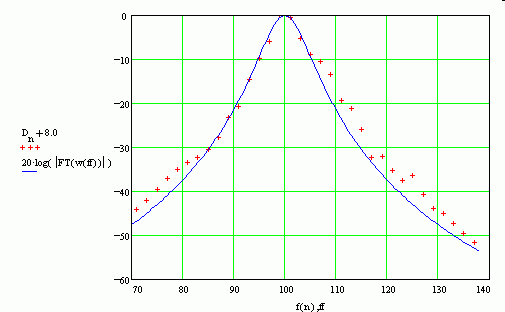Hi Peter,
went through your calculation and basically reproduced your result, with only minor differences:
Following your reasoning, the power in the last bin would be 10^(-59.54/10) * 1.37^2 = 2.087e-6 units. For the power sum of all bins I got 0.464 units, resulting in 4.50 (instead of 4.62) ppm in the 137 kHz bin. With 2.47 kW average, the average power per line would be 41.3 µW - perfect.
I do not think this is too low. This EMRP should produce about 0.5 µV/m at 100 km. My best daytime noise background was on the order of -27 dBµV/m in 1 Hz, so when viewed with in QRSS3 (1.5*0.34 Hz noise bandwidth), the line would obtain 24 dB SNR. Here at 630 km from Sylt, I can only rarely see hints of Loran in QRSS3.
Using MathCad's symbolic solver, the Fourier integration of the analytical formula yields (if i did it right)

using omega = 2 pi (f/kHz - 100) * 0.065, and with the result normalized to 1 at center. It falls off only at -40 dB/decade, as expected for the click of a t^2 pulse start. The following plot shows how the formula fits the spectrum analyzer data:

73 and have a nice weekend
Markus
In einer eMail vom 03.03.2006 10:56:07 Westeuropäische Normalzeit schreibt [email protected]:
From G3PLX:
I calculated the radiated power of a LORAN line now, but I would like other
people to check if I did it right, because the result is surprisingly small.
The spectrum measurement made at Rugby gives a chart of dB levels for 2kHz
steps over 70-130kHz, going from -8dB in the centre to -53dB at 130kHz, and
I extrapolated by eye to estimate the levels at three more steps up to
136kHz. Here are the numbers themselves...
-52.00,-49.95,-47.49,-45.03,-43.10,-41.42,-40.24,-38.42,-35.72,-31.13,-28.75,-22.49,-17.82,-13.84,-8.01,-8.46,-13.29,-16.76,-18.44,-21.41,-27.43,-29.16,-33.89,-40.21,-40.09,-43.32,-45.47,-44.45,-48.63,-51.86,-52.94,-55.24,-57.44,-59.54
Notice that there are two 'largest' figures, so although the chart shows
these two as being at frequencies of 98 and 100kHz, I am guessing that they
are really figures for the centre of bands 98-100 and 100-102kHz. The last
three are my guesses for the values for the bands 132-134, 134-136, and
136-138 kHz. From the other information in the spreadsheet I was sent, I am
quite certain that this spectrum was measured at an antenna current sampling
point.
For each of these figures I calculated the relative "current-squared" values
from 10^(dB/10) then multiply each one by (F/100)^2, where F is the
frequency in kHz. This gives a figure for the relative radiated power in
each 2kHz slot. The square-frequency factor arises because the radiation
resistance will be proportional to F-squared, and I am seeking to calculate
the I-squared-R for each 2kHz slot. The figure I get for the 136-138kHz slot
is 0.0021.
Next I add all these figures to give me a total of 454.6338 units of power.
I don't know what the units are because I don't have enough information
about the transmitter or the antenna, but I can divide 0.0021 by it to give
me the fraction of the total mean power that is radiated in the 136-138kHz
slot. This is 4.62e-6.
For the Lessay chain I know the group repetition interval is 67.31mS which
means there are 14.85 pulse groups per sec. Because half the pulses are
constant polarity and half are alternating, I know that half the energy goes
into spectral lines at this spacing and half goes into lines at odd
multiples of half this figure. Effectively there are twice as many spurious
lines as the GRI says, spaced at 7.43Hz. There are about 270 of these
(2000/7.43) in a band of 2kHz wide.
Therefore the proportion of the total mean power which is radiated in a
single spectral line at 136kHz is 4.62e-6 / 270 = 1.71e-8.
If we estimate (from the info given by Marco) that each LORAN transmitter
radiates 7.5kW mean power, then the radiated power in each LORAN line is
1.71e-8 * 7500 = 0.128 mW.
I don't know if I should believe this! Can anybody find a mistake or at
least check my calculations? All the figures needed for the calculations
are in this email. Does anyone have any evidence that any of these figures
are wrong?
73
Peter G3PLX
|



